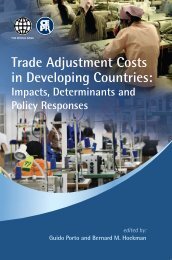Download PDF - Vox
Download PDF - Vox
Download PDF - Vox
- No tags were found...
You also want an ePaper? Increase the reach of your titles
YUMPU automatically turns print PDFs into web optimized ePapers that Google loves.
Financial stability: Where it went and from whence it might return2010). The Argentine default in 2001-2 saw the country emerge from crisis as well orbetter than orthodox Brazil, which took the full ‘medicine’ (Klagsbrunn 2010).The system of international banking supervision was equally flawed. The first effort– from the Market Risk Amendment to Basle I in 1996 through to the finalisation ofBasle II in 2004 – relied on self-supervision by large banks. The key tool was internalrisk assessment and attendant controls. In essence, it was a micro approach to riskmanagement based on market price signals, risk ratings and weightings, and a range offinancial ‘governance’ standards.This market-based approach to the financial sector, or “governance light”, was amplycriticised as procyclical and dangerous (Persaud 2000, Ocampo and Griffith-Jones),and it neglected the macroprudential dimensions of systemic risk (Claessens andUnderhill 2010). The system furthermore provided direct competitive advantages to thesame large-bank constituency that had proposed the idea in the first place. Moreover, itinvolved a substantial rise in the cost of capital for poor countries and their populationswho had no access to the decision-making forum (Claessens et al. 2008).The theories and argument pools from which the new policies were drawn becametilted towards particularistic interests; state officials and the private sector came to shareinterests and approaches to governance in a club-like setting (Tsingou 2012). There wasa serious policy rent-seeking and capture problem in the financial policy community– the input side of the policy process was flawed (Claessens and Underhill) and ideasetson stability of the market skewed as result (Baker 2010). As a result, regulationbackfired. Policies adopted to secure financial stability were those least likely toachieve it! Rather, they provided material advantages to the large financial institutionsthat benefited most from financial liberalisation in the first place.So the 30 years of global financial integration lurched from crisis to skewed reformto crisis once again. Much of the burden of reform was on the emerging markets anddeveloping countries that experienced crises most frequently. Their experience ledthem, particularly after the Asian crisis, to question the market-based approach to59














